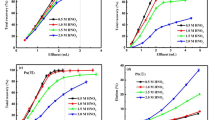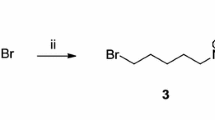Abstract
Due to unexpected Pu behavior using the U/TEVA resin and the most-recognized reagents, some key separation stages need to be studied for the U–Pu separation: Pu valency adjustment, Pu elution solution composition, resin loading rate and Pu elution solution stability over time. The new Pu elution solution developped in the study, composed of 3 × 10–3 mol L−1 ascorbic acid / 3 × 10–3 mol L−1 sulfamic acid / 2 mol L−1 HNO3, helps obtaining a more robust method: recovery yields over 80% and decontamination factor up to 2 × 104. The best separation performances were obtained when the new Pu elution solution was freshly prepared, the resin loading rate did not exceed 30% and with a waiting time for the valency adjustment between the addition of H2O2 and the start of the chromatographic cycle set at 42 h regardless the Pu quantity involved.


Similar content being viewed by others
References
Quemet A, Ruas A, Dalier V, Rivier C (2019) Development and comparison of high accuracy thermal ionization methods for uranium isotope ratios determination in nuclear fuel. Int J Mass Spectrom 438:166–174. https://doi.org/10.1016/j.ijms.2019.01.008
Quemet A, Buravand B, Catanese B, Huot P, Dalier V, Ruas A (2020) Monitoring the dissolution of a uranium-plutonium oxide from a spent fuel solution: using plutonium ratio and TIMS for isotope ratio measurements. J Radioanal Nucl Chem 326:255–260. https://doi.org/10.1007/s10967-020-07311-5
Garcia-Alonso J (2014) I and Rodriguez-Gonzalez P, Isotope dilution mass spectrometry. Anal Bioanal Chem 406:2739–2740. https://doi.org/10.1007/s00216-014-7662-6
Grate JW, O’Hara MJ, Farawila AF, Douglas M, Haney MM, Petersen SL, Maiti TC, Aardahall CL (2011) Extraction chromatographic methods in the sample preparation sequence for TIMS of plutonium isotopes, analytical chemistry. Anal Chem 83(23):9086–9091. https://doi.org/10.1021/ac202150v
Pietri CE, Freeman BP, Weiss J (1981) R, The quantitative ion exchange separation of plutonium from impurities. Rev Sci Instrum 52(8):p1252-1255
Sturm M, Richter S, Aregbe Y, Wellum R, Prohaska T (2016) Optimized chemical separation and measurement by TE TIMS using carburized filaments for uranium isotope ratio measurements applied to plutonium chronometry. Anal Chem 88:6223–6230. https://doi.org/10.1021/acs.analchem.5b03852
Solatie D, Carbol P, Betti M, Bocci F, Hiernaut T, Rondinella VV, Cobos J (2000) Ion chromatography inductively coupled plasma mass spectrometry (IC-ICP-MS) and radiometric techniques for the determination of actinides in aqueous leachate solutions from uranium oxide; Fresenius’. J Anal Chem 68:88–94. https://doi.org/10.1007/s002160000536
Michel H, Barci-Funel G, Dalmasso J, Ardisson G (1999) One step ion exchange process for the radiochemical separation of americium, plutonium and neptunium in sediments. J Radioanal Nucl Chem 240:467–470
Liao H, Wu F, Yamada M, Tan M, Chen J (2008) Determination of plutonium isotopes in freshwater lake sediments by sector-field ICP-MS after separation using ion-exchange chromatography. Appl Radiat Isot 66(8):1138–1145. https://doi.org/10.1016/j.apradiso.2008.01.001
Horwitz E. Ph, (1995) Separation and preconcentration of actinides by extraction chromatography using a supported liquid anion exchanger: application to the characterization of high-level nuclear waste solutions; Analytica Chimica Acta, 310: 63
Nuclear fuel technology — Determination of the isotopic and elemental uranium and plutonium concentrations of nuclear materials in nitric acid solutions by thermal-ionization mass spectrometry. ISO 8299:2019;
Morgenstern A, Apostolidis C, Carlos-Marquez R, Mayer K, Molinet R (2002) Single-column extraction chromatographic separation of U, Pu, Np and Am. Radiochim Acta 90:81–85. https://doi.org/10.1524/ract.2002.90.2_2002.81
Horwitz EP, Dietz ML (1992) Separation and preconcentration of uranium from acidic media by extraction chromatography. Anal Chim Acta 266:25–37
Maillard Ch, Adnet J (2001) M, Plutonium(IV) Peroxide formation in nitric medium and kinetics of pu(vi) reduction by hydrogen peroxide. Radiochim Acta 89(8):485–490
Roudil D, Rigaux C, Rivier C, Hubinois JC, Aufore L (2012) CETAMA Contribution to safeguards and nuclear forensic analysis based on nuclear reference materials. Procedia Chem 7:709–715. https://doi.org/10.1016/j.proche.2012.10.108
Hydroxylammonium chloride - Brief Profile - ECHA; https://echa.europa.eu/brief-profile/-/briefprofile/100.024.362
Gourisse D, Madic Ch (1975) Les reactions d’oxydoréduction des éléments transuraniens. Gmelin Handbuch, Transurane, Vol D1, Chemie in losung, Springer-Verlag
Koltunov VS, Krot NN (1985) New investigation of redox reactions of neptunium and plutonium. Sov Radiochem 27(1):83–107
Brunstad A (1957) Oxidation of Plutonium (III) by Sodium Nitrite. General Electric Company. https://doi.org/10.2172/4345806
Koltunov VS, Marchenko VI (1973) Reaction between plutonium(III) and nitrous acid. I Equilibrium Sov Radiochem 15(5):754–756
Nuclear energy - Nuclear fuel technology - Determination of plutonium in nitric acid solutions by spectrophotometry (ISO 9463:2019)
Pembridge J. R. & Stedman G, Kinetic, Mechanism and stoicheiometry of the oxidation of hydroxylamine by Nitric acid – J. C. S. Dalton, p. 1657 -1663, January 1979
Gowland RJ, Stedman G (1980) Kinetic and products studies on the decomposition of hydroxylaminein nitric acid. J Inorg Nucl Chem 43(11):2859–2862
Raman S, Ashcraft R, Vial M, Klasky ML (2005) Oxidation of hydroxylamine by nitrous and nitric acids. model development from first principle SCRF calculations. J Phys Chem 109:8526–8536
Bennett M. R, Brown G. M, Maya L, Posey F, (1982) Oxidation of hydroxylamine by nitrous and nitric acid, rapport edss-tcNFT, Web. https://doi.org/10.1021/ic00136a066
Bunton CA, Dahn H, Loewe L (1959) Oxidation of ascorbic acid and similar reductones by nitrous acid. Nature 183:163–165
Beake B. D, Moodie R. B and Smith D, Oxidation of ascorbic acid by nitrous acid: conditions where autoxidation of nitric oxide is rate determining, J. Chem. Soc., Perkin Trans. 2, p. 1251–1252, 1995
Zebrovsky E and Feber R. C, Sulfamic acid in the redox process. General electric company, July 15, 1948
Tober F. W and Russell E. R, Concentration of Plutonium by cation exchange stabilization of Pu(III) in nitric acid, Chemistry – Separation PROCESSES for plutonium and uranium (M-3679 22nd Ed., Rev.1),February 1959
Connick R. E and Mc Vey W. H, Note on the oxidation of plutonium (III) by nitrate ion; in the Transuranium elements, Glenn T. Seaborg, 1949
Dukes EK (1960) Kinetics and mechanisms for the oxidation of trivalent plutonium by nitrous acid J. Soc, Am Chem. https://doi.org/10.1021/ja01486a003
Author information
Authors and Affiliations
Corresponding authors
Additional information
Publisher's Note
Springer Nature remains neutral with regard to jurisdictional claims in published maps and institutional affiliations.
Rights and permissions
About this article
Cite this article
Maillard, C., Maloubier, D., Boulay, O. et al. U and Pu separation with U/TEVA resin: Influence of some parameters on chromatographic cycle performances. J Radioanal Nucl Chem 330, 579–587 (2021). https://doi.org/10.1007/s10967-021-07986-4
Received:
Accepted:
Published:
Issue Date:
DOI: https://doi.org/10.1007/s10967-021-07986-4




